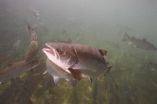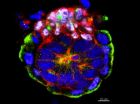(Press-News.org) University of British Columbia scientists have found for the first time an infectious form of
the cat parasite Toxoplasma gondii in western Arctic Beluga, prompting a health advisory to the
Inuit people who eat whale meat.
The same team also discovered a new strain of the
parasite Sarcocystis, previously sequestered in the icy north, that is responsible for killing
406 grey seals in the north Atlantic in 2012.
Presenting their findings today at the 2014
Annual Meeting of the American Association for the Advancement of Science (AAAS), Michael Grigg
and Stephen Raverty from UBC's Marine Mammal Research Unit say that the "big thaw" occurring in
the Arctic is allowing never-before-seen movement of pathogens between the Arctic and the lower
latitudes.
"Ice is a major eco-barrier for pathogens," says Michael Grigg, a molecular
parasitologist with the U.S. National Institutes of Health and an adjunct professor at UBC.
"What we're seeing with the big thaw is the liberation of pathogens gaining access to vulnerable
new hosts and wreaking havoc."
Toxoplasmosis, also known as kitty litter disease, is the
leading cause of infectious blindness in humans and can be fatal to fetuses and to people and
animals with compromised immune systems.
"Belugas are not only an integral part of Inuit
culture and folklore, but also a major staple of the traditional diet. Hunters and community
members are very concerned about food safety and security," says Raverty, a veterinary
pathologist with the B.C. Ministry of Agriculture and Lands' Animal Health Centre and an adjunct
professor at UBC. Raverty has led the systematic sampling and screening of hunter-harvested
Beluga for 14 years.
Grigg has also identified the culprit of the 2012 grey seal die-off
as a new strain of Sarcocystis. While not harmful to humans, the Arctic parasite, which was
named Sarcocystis pinnipedi at the AAAS meeting today, has now killed an endangered Steller sea
lion, seals, Hawaiian monk seals, walruses, polar and grizzly bears in Alaska and as far south
as British Columbia.
INFORMATION:
NB: Related images, a ready-to-post video, raw interviews and
b-roll are available at news.ubc.ca/category/aaas after 3pm EST Feb. 13.
Visit
news.ubc.ca for more story ideas, media-friendly experts and subscribe to UBC science media
releases.
BACKGROUND
- Toxoplasmosis and health concerns
Toxoplasma is
spread mainly through consuming of undercooked meat or water that has come in contact with soil
contaminated by cat feces.
It is estimated that up to one-third of the world's human
population carry Toxoplasma. While not a major concern for healthy individuals, Toxoplasmosis
can be fatal to the fetuses of pregnant women and immune-deficient individuals. It first gained
notoriety as an AIDS-defining infection.
In 1987, all four out of 30 women in a northern
Quebec village exposed to Toxoplasma during pregnancy gave birth to congenitally infected
children. The most significant risk factor attributed to this high incidence rate in northern
Quebec was the consumption of dried seal meat. The rate of maternal infection during pregnancy
in North America is six in every 1,000 pregnancies.
UBC researchers had previously
identified Toxoplasma infecting marine mammals in the northern Pacific region, but finding the
parasite in hunter-harvested Belugas of the western Arctic raises public health concerns. These
animals are consumed by the Inuit people as a recognized part of their traditional culture.
"The Inuit's traditional processing and cooking methods should be enough to kill Toxoplasma,
but vulnerable populations like pregnant women need to be extra vigilant around handling and
consuming raw whale meat," says Grigg.
- Pathogens and ecological barriers
Protozoan parasites like Toxoplasma and Sarcocystis infect and remain dormant in many animal
hosts. Infectious forms of the parasite are only shed in the environment by "definitive hosts."
Cats are definitive hosts for Toxoplasma. A variety of definitive hosts exist for the
Sarcocystis parasites.
Arctic ice sheets have previously served as an ecological barrier,
limiting the circulation of pathogens between cold and warm climates. Climate change has
affected the ice sheet barrier, facilitating pathogen spread to new, susceptible marine and land
animals that now access the Arctic.
- Marine mammals: Sentinels of ecosystem health
Seals, walruses and polar bears rely on seasonal sea ice for habitat and must adapt to the
sudden loss of ice, while migratory species such as whales appear to be finding new prey,
altering migration timing and moving to new habitats.
"Marine mammals can act as
ecosystem sentinels because they respond to climate change through shifts in distribution,
timing of their movements and feeding locations," says Sue Moore, an oceanographer with the
National Oceanic and Atmospheric Administration and a collaborator of Grigg and Raverty. "These
long-lived mammals also reflect changes to the ecosystem in their shifts in diet, body condition
and physical health."
Cat parasite found in western Arctic Beluga deemed infectious
2014-02-14
ELSE PRESS RELEASES FROM THIS DATE:
NOAA researcher says Arctic marine mammals are ecosystem sentinels
2014-02-14
As the Arctic continues to see dramatic declines in seasonal sea ice, warming temperatures and increased storminess, the responses of marine mammals can provide clues to how the ecosystem is responding to these physical drivers.
Seals, walruses and polar bears rely on seasonal sea ice for habitat and must adapt to the sudden loss of ice, while migratory species such as whales appear to be finding new prey, altering migration timing and moving to new habitats.
"Marine mammals can act as ecosystem sentinels because they respond to climate change through shifts in distribution, ...
Stanford psychologist shows why talking to kids really matters
2014-02-14
Fifty years of research has revealed the sad truth that the children of lower-income,
less-educated parents typically enter school with poorer language skills than their more
privileged counterparts. By some measures, 5-year-old children of lower socioeconomic status
(SES) score two years behind on standardized language development tests by the time they enter
school.
In recent years, Anne Fernald, a psychology professor at Stanford University, has
conducted experiments revealing that the language gap between rich and poor children emerges
during infancy. ...
For understanding family structure to trauma: New technology is yielding bigger data
2014-02-14
Austin - February 13, 2014 - Social media can do more than just entertain us and keep us connected. It also can help scientists better understand human behavior and social dynamics. The volume of data created through new technology and social media such as Facebook and Twitter is lending insight into everything from mapping modern family dynamics to predicting postpartum depression.
"By analyzing different types of social media, search terms, or even blogs, we are able to capture people's thinking, communication patterns, health, beliefs, prejudices, group behaviors – ...
Genetic chip will help salmon farmers breed better fish
2014-02-14
Atlantic salmon production could be boosted by a new technology that will help select the best fish for breeding.
The development will enable salmon breeders to improve the quality of their stock and its resistance to disease.
A chip loaded with hundreds of thousands of pieces of DNA – each holding a fragment of the salmon's genetic code – will allow breeders to detect fish with the best genes.
It does so by detecting variations in the genetic code of each individual fish – known as single nucleotide polymorphisms (SNPs). These variations make it possible to identify ...
Discovery may help to explain mystery of 'missing' genetic risk
2014-02-14
A new study could help to answer an important riddle in our understanding of genetics: why research to look for the genetic causes of common diseases has failed to explain more than a fraction of the heritable risk of developing them.
Susceptibility to common diseases is believed to arise through a combination of many common genetic variants that individually slightly increase the risk of disease, plus a smaller number of rare mutations that often carry far greater risk.
However, even when their effects are added together, the genetic variants so far linked to common ...
Mixed genes
2014-02-14
This news release is available in German. When individuals from different groups interbreed, their offspring's DNA becomes a mixture of the DNA from each admixing group. Pieces of this DNA are then passed along through subsequent generations, carrying on all the way to the present day. Researchers from the Max Planck Institute for Evolutionary Anthropology in Leipzig, Germany, Oxford University and University College London (UCL) have now produced a global map detailing the genetic histories of 95 different populations across the world, spanning the last four millennia.
The ...
Study highlights indigenous response to natural disaster
2014-02-14
DENVER (Feb. 13, 2014) – When a tsunami struck American Samoa in 2009, indigenous institutions on the islands provided effective disaster relief that could help federal emergency managers in similar communities nationwide, according to a study from the University of Colorado Denver and the University of Hawaii at Manoa.
The study found that following the tsunami, residents of the remote U.S. territory in the South Pacific relied on Fa'aSamoa or The Samoan Way, an umbrella term incorporating a variety of traditional institutions governing the lives of its citizens.
"We ...
Berkeley Lab researchers at AAAS 2014
2014-02-14
Can more accurate climate models help us understand extreme weather events? Can we use
synthetic biology to create better biofuels? These questions, and the ongoing search for Dark
Matter and better photovoltaic materials, are just some of the presentations by Lawrence
Berkeley National Lab researchers at this year's AAAS meeting. Here's a quick look at Berkeley
Lab@AAAS:
Friday, Feb. 14
1:00-2:30
Opportunities for New Materials in
Photovoltaics (Toronto Room, Hyatt Regency)
Ramamoorthy Ramesh
The
Department of Energy's ...
Superconductivity in orbit: Scientists find new path to loss-free electricity
2014-02-14
UPTON, NY—Armed with just the right atomic arrangements, superconductors allow electricity to flow without loss and radically enhance energy generation, delivery, and storage. Scientists tweak these superconductor recipes by swapping out elements or manipulating the valence electrons in an atom's outermost orbital shell to strike the perfect conductive balance. Most high-temperature superconductors contain atoms with only one orbital impacting performance—but what about mixing those elements with more complex configurations?
Now, researchers at the U.S. Department of ...
Rewriting the text books: Scientists crack open 'black box' of development
2014-02-14
We know much about how embryos develop, but one key stage – implantation – has remained a
mystery. Now, scientists from Cambridge have discovered a way to study and film this 'black box'
of development. Their results – which will lead to the rewriting of biology text books worldwide
– are published in the journal Cell. Embryo development in mammals occurs in two phases.
During the first phase, pre-implantation, the embryo is a small, free-floating ball of cells
called a blastocyst. In the second, post-implantation, phase the blastocyst embeds itself in the
mother's ...



